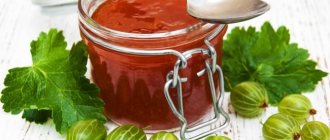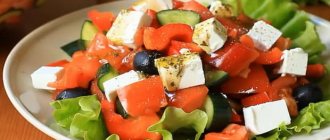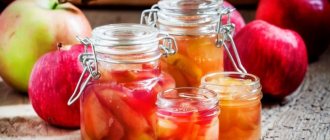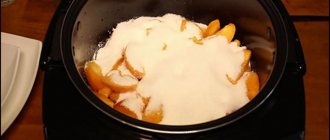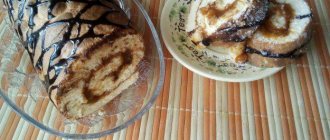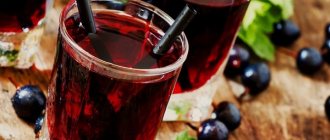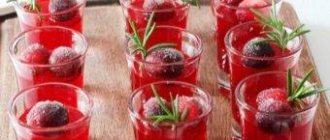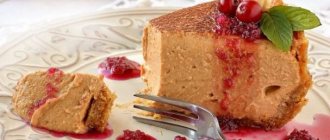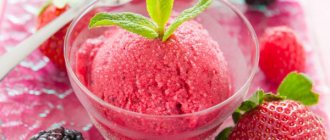How to make confiture
Confiture is a dish that came to us from Europe, and its name itself is of French origin.
According to the classic definition, confiture can be considered a jelly-like food product with fruits or berries evenly distributed in it and with sugar. Confiture has much in common with other sweet preparations for the winter - jam, marmalade, marmalade, jelly. But it has a couple of key differences from such preparations: confiture differs from jelly and marmalade in the presence of pieces of fruit or berries, and from jam and marmalade – it has a jelly-like consistency.
The preparation of classic confiture is usually divided into two main stages. At the first stage, thick syrup is cooked from sugar and water or juice, and at the second stage, fruits or berries are boiled in the resulting syrup. Let's take a closer look at how each stage occurs.
Cooking syrup for confiture
For confiture, syrup is cooked from a small amount of liquid and a fairly large amount of sugar. Plain water can be used as the base for the syrup, but you can also take juice or dry white wine.
The syrup is boiled until it is tested for a “thin thread”. Periodically scoop it up with a spoon or spatula, and then check: if the last drop of syrup, falling, pulls a “thread” with it, then it is ready.
Boiling fruits and berries in syrup
When the syrup is ready, whole or cut into pieces fruits or berries are immersed in it, and then cooked over low heat until the syrup thickens. Most recipes for preparing confiture use one-time cooking, but there are also recipes that require cooking fruits and berries in syrup in 2 or more steps.
The readiness of confiture for packaging is determined by its thickness. If a drop of confiture syrup on a clean, dry saucer does not spread and becomes covered with a thin film that wrinkles when pressed, then the confiture can be removed from the heat.
Application
Advertising poster of Glavkonserv of the USSR “Everyone can benefit from jam.”
Jams have proven themselves well in products subject to heat treatment (baking or freezing): for open and closed pies, for puff pastries, as a filling for pancakes, frozen semi-finished products (dumplings). Heat-stable jams do not leak or spread during baking, retain all their taste, and are resistant to freezing and thawing. Also, both heterogeneous and homogeneous jams are perfect for ice cream, yoghurts, glazed curds, curd masses and desserts.
Features of preparing confiture at home
In order for the confiture to have a jelly-like consistency, it should be prepared from pectin-rich fruits or berries. For example, apples, gooseberries and currants boast a high content of pectins, apricots, plums, strawberries and blackberries have somewhat less, and raspberries, cherries, cherries and blueberries have very little pectin.
If you need to cook confiture from fruits with a low pectin content or if you need to reduce the cooking time, then pectin can be added to the confiture separately - in powder form or as part of a special gelling sugar. The latter, in addition to pectin, usually contains additional citric acid and sugar. To use, gelling sugar is mixed with regular sugar according to the manufacturer's instructions.
During prolonged cooking, the color and aroma of fruits and berries may deteriorate, so confiture should be prepared in small portions - up to 1.5 kg at a time. And in this case, it is very convenient to resort to the help of a multicooker, if you have one: with it, the risk that the confiture will burn is minimal.
As you can see, cooking confiture for the winter at home is not too difficult, especially if you know the basic rules for its preparation. And when you master the basic recipes for this delicious delicacy, be sure to try to diversify your preserves by adding various spices to your confitures - you will be guaranteed unearthly gastronomic bliss!
How to prepare confiture for the winter
It turns out that confiture for the winter can be made not only from fruits and berries, but also using vegetables (for example, tomatoes and cucumbers) or crops with melons for these sweet preparations. In the classic recipe for industrial production, gelling agents - pectin, gelatin or agar-agar - are used to prepare confiture. But at home you can completely do without these components. Learn how to prepare confiture with and without thickeners.
What is confiture?
The mysterious word “confiture” came to us from the French language and is translated as “cooked in sugar.” Confiture is considered to be whole (chopped) berries and some types of vegetables, boiled in sugar with the addition of agar-agar or pectin.
The first semblance of a jelly-like fruit delicacy was invented in Hungary, but it was French chefs who significantly improved the recipe. For the first time, gelatin was used to prepare dessert, which was later replaced with inexpensive beet sugar.
Recipes for making fruit confiture at home
Apple confiture with raisins.
Ingredients:
- 1 kg apples
- 500 g sugar
- juice of 12 lemons
- 15 g raisins
- 500 ml water
Cooking method:
Wash the apples, peel and cut into slices. Place in a saucepan, add water and cook for about 30 minutes from the moment it boils. Then squeeze out the mass. Add sugar to the resulting juice, bring to a boil and cook, stirring, over low heat until tender. Add lemon juice and pre-soaked and squeezed raisins. Place the confiture prepared according to this recipe into jars while hot, roll it up and put it in a cool place.
Quince confiture.
Ingredients:
- 1.5 kg quince
- 1 kg sugar
- 300 ml decoction
- 8 g citric acid
Cooking method:
To prepare confiture for the winter according to this recipe, the ripe fruits need to be washed, peeled, cut into 4 parts, cored and placed in acidified water (2.5 g of citric acid per 1 liter). Separately prepare a decoction from the peel and seed pods cut from the fruit. Prepare syrup from the broth, bring it to a boil, add grated quince. Cook until the pieces become translucent and the syrup thickens. A few minutes before it’s ready, add citric acid to the confiture, put it in jars, and close it.
Quince confiture with vanilla.
Ingredients:
- 1 kg quince
- 500 g sugar
- 300 ml water
- 5 g citric acid
- vanilla pod
Cooking method:
Before making such confiture, the quince must be washed, peeled, and cut into small cubes. Prepare syrup from water and sugar, add citric acid, add quince. Bring to a boil and cook over medium heat for 20 minutes, stirring with a wooden spoon. Then remove from heat, leave for 6 hours, then boil again. Place the hot fruit confiture into jars and roll up.
Berry preserves for the winter: homemade recipes
Strawberry confiture.
Ingredients:
- 1 kg strawberries
- 500 g sugar
- juice and zest of 1 lemon
- 30 ml liqueur
Cooking method:
Before preparing such confiture at home, the berries need to be washed, stems removed, and cut into small pieces. Add lemon zest and juice, put on heat and, stirring, bring to a boil, then cook for 3-4 minutes. Pour in the liqueur, mix well. Place the hot confiture into jars and roll up.
Strawberry-ginger confiture.
Ingredients:
- 1.5 kg strawberries
- 500 g sugar
- 50-70 g ginger root
Cooking method:
Cut the strawberries into pieces, grate the ginger. Add sugar, bring to a boil and simmer for 10 minutes. Place the hot berry confiture prepared for the winter into jars and roll up.
Raspberry confiture with lemon.
Ingredients:
- 1 kg raspberries
- 1 kg sugar
- juice and zest of 1 lemon
- 5 g gelatin
Cooking method:
Sort out the raspberries, place in a large saucepan, add lemon juice and zest, sugar, gelatin, mix well. Place the mixture on the fire and bring to a boil with constant stirring. Boil for 3-4 minutes over low heat, stirring carefully and skimming off the foam. Place the hot confiture into sterilized jars, roll up, and turn over for 30 minutes.
STEP #1
STEP #2
STEP #3
STEP #4
Store in a dark and cool place.
Melon confiture.
Ingredients:
- 1 kg melon pulp
- 1 kg sugar
- 5 g citric acid
Cooking method:
Cut the melon pulp into cubes, place in a saucepan, sprinkle with sugar, shake well and leave overnight. In the morning, mix carefully, leave for another 6-7 hours. Then mix well, put on fire, let simmer for 5-7 minutes and set aside for 8 hours. Repeat the procedure 2 more times. At the end of cooking, add citric acid. Place the hot confiture into jars and roll up. Store in a cool, dark place.
Grape confiture.
Ingredients:
- 1 kg seedless grapes
- 1 orange
- 500 g sugar
- 10g pectin
Cooking method:
Before making such confiture at home, the grapes need to be washed, placed in a container, covered with sugar and left for 2 hours to release the juice. Then put on fire, bring to a boil, boil for 2 minutes and set aside until completely cooled. Repeat the procedure 3-4 times. During the last cooking, add orange pulp, add pectin and boil for no more than 3 minutes. Place the hot confiture into jars and roll up.
Redcurrant confiture.
Ingredients:
- 1 kg red currants
- 1 kg sugar
- juice of 12 oranges
Cooking method:
Wash the red currants, dry them, and separate the stems. Pass the berries through a meat grinder, then rub through a sieve to remove small seeds. Add sugar to the resulting juice, put on fire and cook for about 30 minutes, stirring constantly. At the end of cooking, add orange juice and cook until desired thickness. Place the hot berry confiture prepared according to this recipe into jars, roll it up, and leave it in a cool place for a while.
How else can you make fruit jam at home?
Confiture of apples and apricots.
Ingredients:
- 500 g apricots
- 2 green apples
- 400 g sugar
- 12 cinnamon sticks
Cooking method:
For this recipe for making fruit confiture, apples need to be peeled and cut into slices. Then place in a saucepan, fill halfway with water, bring to a boil over low heat, and simmer for 5 minutes. Squeeze through cheesecloth, add sugar and cinnamon to the resulting juice, boil for 30 minutes. Add chopped apricots to the boiling syrup, bring to a boil, boil to the desired thickness, remove the cinnamon. Place the hot confiture into jars and roll up.
Confiture of apricots and bananas.
Ingredients:
- 750 g apricots
- 250 g bananas
- zest of 12 lemons
- 1 kg sugar
- 150 ml water
Cooking method:
Before cooking the jam, apricots and bananas need to be cut into small pieces. Then place in a saucepan, add lemon zest, sugar, water, bring to a boil and cook for 5-7 minutes. Remove from heat, remove foam. Place the hot confiture into jars and roll up.
Peach confiture with cognac.
Ingredients:
- 1 kg peaches
- juice of 2 lemons
- 1 kg sugar
- 100 ml cognac
Cooking method:
Wash the peaches, dry them, cut them into cubes, pour in lemon juice and cognac, add 200 g of sugar, shake or stir gently with a wooden spatula so that all the slices are covered with the mixture. Place in the refrigerator for 10-12 hours. In the morning, bring the peaches to a boil and simmer over low heat for 15-20 minutes. Add the remaining sugar and cook until thick, skimming off the foam. Place the hot confiture prepared according to this recipe at home into jars and roll up.
For colds
One of the healthiest desserts in the winter season will be confiture made from oranges, lemons and ginger.
List of ingredients:
- three oranges and three lemons (total 1.3 kg);
— fresh ginger — 150 g;
— water — 200-250 ml;
- sugar - 1.5 kg.
Wash the citrus fruits thoroughly and cut into small slices, then pass through a meat grinder or grind in a blender. Add water to the resulting mass and after boiling, wait two minutes.
Pour sugar into a saucepan, bring to a boil and cook for 15 minutes. Peel fresh ginger, grind it in a blender and add it to the finished confiture. We put the dessert in small jars and store it in the refrigerator - the best cure for colds is ready.
Cooking Basics: How to Make Jam and Jelly
We present to you the last part of our series of materials about sweet preparations. Today we will tell you how to properly prepare and preserve confiture and jelly for the winter.
We have already told you how to prepare for preparing preparations, how to make jam, marmalade and marmalade. Today we have similar, but very different sweets: thick confiture and aromatic jelly.
Confiture is a close “relative” of jam. They have several differences:
- confiture is thicker and more jelly-like;
- pectin, gelatin or agar-agar are added to it;
- It cooks faster than jam.
Confiture can be cooked either from pureed fruits or left in pieces. Ready-made confiture is eaten as a dessert, spread on bread or layered into cakes.
What to cook from
Usually confiture is made from fruits and berries with a high pectin content. As we have already said, these are apples, quinces, gooseberries, currants and plums. With such fruits there is no need to add a thickener. But if you decide to cook confiture from kiwi or, for example, cherries, you cannot do without pectin or gelatin.
How to cook
Cooking confiture is not at all difficult, the main thing is to know some subtleties:
- for 1 kilogram of fruit you will need from 600 grams to 1 kilogram of sugar, depending on their sweetness;
- at the end of cooking, add 2 grams of citric acid per 1 kilogram of fruit to the confiture. Citric acid can be replaced with a teaspoon of wine vinegar;
- pectin, agar-agar or gelatin are added at the end of cooking, the confiture is allowed to boil or heated and transferred to sterilized jars.
Now let's take a closer look at how to cook confiture.
Cooking syrup
First, you will need to boil the syrup - you can use both water and fruit juice for it. For 1 kilogram of sugar you need 1 glass of liquid. Boil water or juice, then add sugar and, stirring, boil it. To find out if the syrup is ready, do a “string” test: lift the spoon with the syrup above the bowl in which it was boiled and look - if the last drop from the spoon stretches, forming a string, the syrup is ready.
Adding fruit
Now you can add fruits and berries to it. Cut the peeled fruits into small pieces; soft berries and fruits can be pureed. Place the fruit in the syrup and bring it to a boil over high heat. Stirring, cook the fruit for about 10-15 minutes.
Thickeners
The proportions for all three thickeners are the same: for 1 kilogram of fruit you will need 10 grams of pectin, gelatin or agar-agar.
If you need to add pectin
, add it at the very end, reduce the heat and let the confiture simmer for another 5 minutes.
If you are cooking with gelatin
, put it in cold water (you need a little water, just for it to swell - about 50 milliliters per 10 grams of gelatin), and at the end of cooking, add it to the confiture and heat for 3 minutes. The confiture should not boil after adding gelatin.
Regarding agar-agar
, it needs to be diluted with warm water (about 50 milliliters), stirred until it dissolves, added to the confiture and boiled for 3-5 minutes.
The confiture is ready if a drop of it does not spread on a cold plate. After the drop has cooled, try to move it - if wrinkles appear on it, the confiture is ready!
Confiture in a well-sterilized jar will be stored for 1 year or more.
You can also prepare jelly for the winter, and then serve it for dessert and remember the hot summer. The difference between jelly and other sweet preparations is that it is made from the juice of fruits and berries. In some types of jelly - for example, from red currants or gooseberries, you don’t even need to add gelatin: the juice of these berries contains enough pectin for the finished jelly to acquire the desired consistency.
What to cook from
As in the case of confiture, fruits and berries with a large amount of pectin are suitable for jelly. Gelatin or agar-agar will need to be added if you are making jelly from:
How to cook
In order for the jelly to stand for a long time and not lose its taste and shape, it is important to know a few rules:
- sugar
: if you are preparing jelly without gelatin or agar-agar, the minimum amount of sugar per 1 liter of fruit juice is 700 grams. On average, 800-900 grams of sugar are added. If thickeners are used, sugar may not be added at all; - water
: if you have thick juice - for example, peach, apricot, plum, then you need to dilute it with water so that it becomes a little more liquid (about 200-300 milliliters of water per liter of juice); - thickeners
: for 1 liter of juice you will need 20 grams of agar-agar. As for gelatin, there are two options: for jelly that will shake, you will need 20 grams of gelatin per 1 liter of juice. For a dense jelly that can be cut with a knife, take 50-60 grams of gelatin.
Jelly without thickeners
So, you took fruit juice rich in pectin. Add sugar to it (for 1 liter of juice - from 700 grams to 1 kilogram) and let it simmer over low heat. When the syrup thickens and flows from the spoon in threads, the jelly is ready - pour into jars and close.
This method has one disadvantage: boiling will destroy most of the vitamins.
Jelly with gelatin
As we have already said, for 1 liter of juice you will need from 20 to 60 grams of gelatin, depending on the density of the jelly. Pour juice into gelatin at the rate of 350 milliliters of juice per 20 grams of gelatin and leave for about an hour. Then put the swollen gelatin on the fire and heat it - make sure that it does not boil, otherwise the jelly will not turn out. Then mix the remaining juice with gelatin, stir well, add sugar if necessary. Heat the mixture for about 5 minutes, stirring until the sugar dissolves, and pour into jars.
Jelly with agar-agar
Unlike gelatin, agar-agar must be boiled. Heat half the juice, add agar-agar to it, stir well and bring to a boil. At this point you can add sugar. Then add the remaining juice and boil for about 5 minutes. Now you can pour the jelly into jars.
To test the readiness of the jelly, drop it onto a cold plate. If the jelly has set, it is ready.
Jelly is stored in the same way as other preparations - for a year.
*Photos taken from open sources on the Internet.
Subscribe to our telegram channel and stay updated on new materials!
Confiture is a product that is classified as dessert. Its characteristic feature is a dense jelly-like structure, created through the use of gelling substances (agar-agar, pectin, gelling sugar, etc.).
To prepare this dish, fresh (sometimes frozen) berries, fruits, and some vegetables are used. It should be noted that small fruits are boiled whole, while large ones are pre-chopped into pieces of the required size.
They are usually boiled in highly concentrated sugar syrup, adding thickening and gelling agents. There are recipes that contain combinations of fruit and berry raw materials. Such confitures have interesting shades of color and taste.
The term "confiture" is derived from the French word "confiture". In France, it is customary to call any type of jam this way.
Some people equate confiture with jam. But in fact this is wrong! Although the main ingredients for preparing these two products are the same, in jam the fruits become deformed and softened during heat treatment, and in most varieties of confiture they do not lose their shape and are evenly distributed throughout the entire mass.
And their consistency is different: confiture has a jelly-like consistency, while jam has a spreadable consistency. Indeed, the formulation of the second product does not provide for the presence of any gelling substances.
Confiture is usually served as a dessert with coffee or tea; it also often serves as a filling for pastries and pancakes. It is also good as an addition to porridge, cottage cheese, yoghurt, and ice cream. Certain varieties of confiture can serve as the basis for sauces that are added to meat or vegetables.
All boiled confitures can be prepared for future use and stored for a long period of time. They must be poured while still hot into sterile glass jars and tightly closed with lids (it is better to roll them up with metal ones).
Confiture “Sunny”
Required:
- 1kg apricots,
- 800g sugar,
- 2 tbsp lemon juice,
- 1 packet of vanillin,
- 1 packet of jam thickener.
Preparation:
- The berries need to be washed, cut in half, removed the seeds and only then weighed (there should be at least 1 kilogram).
- Add 400 grams of sugar and leave overnight.
- The next day, add lemon juice, vanillin and the remaining half of the sugar.
- Let the mixture simmer over low heat, remembering to stir until the sugar dissolves.
- And then increase the heat and cook it for another 15 minutes, periodically removing the resulting foam.
- After the specified period of time, add a jam thickener and cook the jam for about 10-12 minutes.
Strawberry confiture with a light orange aroma
Required:
- 1 kg fresh strawberries,
- 1 kg gelling sugar,
- 5 tbsp orange liqueur (optional).
Preparation:
- Strawberries should first be carefully washed, peeled and cut into pieces.
- The orange, washed with hot water, must be dried and then grated on a fine grater.
- Prepared strawberries should be mixed with gelling sugar in a tall saucepan, cover with a lid and let stand for about 3-4 hours.
- After this, add grated orange zest.
- Put the mixture on fire.
- Stirring constantly, bring to a boil and cook for another 4 minutes at a high boil, still continuing to stir.
- At the end of the confiture cooking process, you can add orange liqueur.
- A simple tip for checking the readiness of strawberry jam
- To check the strawberry confiture for the required degree of gelling, you need to drop a little hot product onto a cold plate.
- Let it cool slightly, and then turn the dish vertically.
- If the drop has watery edges or starts to flow, the confiture should be cooked further.
- A dense drop that does not spread is evidence of complete readiness.
Raspberry confiture, prepared without cooking
Required:
- 125ml ripe raspberries,
- 125g gelling sugar.
Preparation:
- The raspberries must be carefully sorted and lightly rinsed under running cool water.
- And then put the berries in a bowl and mash with a fork until pureed (you can use a blender for this purpose).
- Gelling sugar should be gradually added to the raspberries, continuing to vigorously beat the whole mass for about another 20-25 minutes (until it thickens).
Recommendations for the preparation and storage of raspberry jam that does not require cooking
- In the process of preparing this type of confiture, the quality of the berries used plays a very important role. Therefore, they should be sorted out carefully.
- Such confiture can be stored in the refrigerator, even in carefully sterilized jars, for only 10-15 days.
Apricot-melon confiture
Required:
- 600g ripe apricots,
- 250g gelling dietary fructose,
- 1 melon,
- 1 lemon.
Preparation:
- First, the apricots must be doused with boiling water.
- After peeling, cut in half and remove the seeds.
- You need to cut the melon, carefully remove the seeds with a spoon and cut out about 200 grams of pulp.
- Apricots along with melon pulp must be turned into puree using a blender.
- In a tall saucepan, combine it with gelling sugar and juice squeezed from lemon.
- Bring the whole mass to a strong boil, stirring constantly, and cook for another 4 minutes.
Original tips for preparing apricot and melon confiture
- To give apricot-melon confiture a unique aroma, at the end of the cooking process you can add 2 tablespoons of plum liqueur or cognac to it.
- If there is no lemon, then you can add 1 teaspoon of citric acid to this type of confiture instead.
Confiture with rhubarb and bananas
Required:
- 750g rhubarb,
- 1 kg gelling sugar,
- 2 bananas
- 1 lemon (juice).
Preparation:
- Bananas need to be peeled, placed in a bowl and mashed thoroughly with an ordinary fork.
- Wash the rhubarb, peel and cut into pieces.
- Then you need to weigh the bananas and add enough chopped rhubarb to them so that the total weight is 1 kilogram.
- Place them in a tall saucepan and mix with gelling sugar and lemon juice.
- Without forgetting to stir constantly, this mass must be brought to a boil. And cook for another 4 minutes at a high boil.
Recommendations for preparing rhubarb-banana jam
- To prepare confiture, it is better to use rhubarb with red stems. After all, green stems are very sour and you will need a lot more sugar.
- Rhubarb petioles spoil quickly. At room temperature they can be stored for only 2 days, and at zero temperature - about 5-7 days.
- Rhubarb stems should be stored wrapped in cellophane film.
- Do not use aluminum or copper utensils for cooking rhubarb. Because at high temperatures, the substances contained in it will contribute to its oxidation.
What is confiture? Fruit Recipes
Translated from French, the name of this dessert means boil in sugar; it has a fairly thick and viscous consistency.
Confiture is one of the best jelly-like treats, which is prepared with sugar and fruits and berries. The finished dessert goes well with coffee and tea; it is the most optimal and profitable alternative to pastries, pies, and various confectionery products. The main advantage of the dish is that it is made exclusively from healthy and natural ingredients. It’s interesting that there are several confiture recipes for those who watch their figure and want to lose weight. Thanks to step-by-step recipes, some subtleties and tricks, it is possible to quickly and without hassle prepare the most delicious, tender, aromatic confiture.
Specifics of preparation
An excellent treat can be made based on melons, fruits and vegetables, as well as berries. The main difference between jam and preserves is in the raw materials and technological process. As for jam, the fruits should be firm and fresh; other types of desserts allow you to use even soft, overripe fruits.
To prepare the most delicious, healthy and appetizing confiture, it is allowed to use not only fresh ingredients, but also frozen ones, but, in this case, the fruits are doused with boiling water and thoroughly cleaned. Then boil it in a specific amount of sugar, add any thickener or gelatin, not forgetting citric acid.
If you add a little vanillin, it will turn out quite original and bright. It is important to remember that the dessert must be constantly stirred during the cooking process. If the composition contains pieces of fruit, then this is done not with a spatula, but by rotating the container.
Recipe for strawberry candy with pectin
There are a huge number of ways to prepare the presented dessert. First you need to choose the main ingredient, namely seasonal raw materials. Agar-agar, pectin or gelatin should be used as a thickener. To make the treat more dietary and low-calorie, sugar should be set aside and stevia used instead.
Preparing confiture for the winter is very simple. You can take strawberries, then wash them, remove the seeds, it is advisable to take large berries. The finished dessert goes well with coffee and tea, it is eaten with a spoon and spread on any baked goods.
Beneficial features
Confiture contains a large amount of vitamins, minerals, and dietary fiber necessary for the proper functioning of the gastrointestinal tract. The confiture is prepared over high heat in special vacuum installations, and this allows you to preserve most of the beneficial substances of the natural ingredients that make up its basis. In addition, the confiture contains products such as agar-agar and gelatin. Seaweed is used to produce agar-agar, as a result of which this product is rich in iodine, iron and calcium. Its main properties include the ability to cleanse the body and blood, as well as stimulate the liver. In turn, gelatin is generously saturated with collagen, which is necessary for the functioning of the brain and nervous system. It strengthens the heart muscle, improves the appearance of skin, nails and hair. The confiture also contains pectin, a substance aimed at natural cleansing and general rejuvenation of the body. Not so long ago, fructose-based confiture appeared in production. This option does not contain sugar, so it is great for people suffering from diabetes or simply adhering to a healthy diet.
The secret of making fruit dessert
Apricot is a unique fruit because it contains a huge amount of gelling elements. That is why, very often it plays the role of gelatin. Considering that the composition contains a lot of sugar, the finished treat will be suitable for all sweet tooths.
To make the delicacy more original, bright and piquant, you should add raspberries, orange and lemon, mint and even carrots. It takes about four hours to prepare four servings. As for the final calorie content, one hundred grams of fruit confiture contains about 197 kcal.
List of ingredients:
- currants – 100 grams;
- apricot – 1 kilogram;
- sugar – 1 kilogram.
Technological process:
- Prepare all ingredients, combine sugar with a small amount of water and bring to a boil.
- Peel the apricots, mix with currants and place in boiling syrup.
- Cook the mixture over low heat until it boils, stirring and skimming off the foam that appears on the surface.
The finished dessert will be very sweet, so you can eat it with tea and coffee without adding sugar.
How is it different from jam and marmalade?
Confiture is a fruit, berry or vegetable loose jelly with a sweet taste and delicate consistency.
- It differs from jam in that it contains gelling agents.
- It differs from jam in that the berries and fruits are not ground, but whole or in pieces.
Therefore, such a dessert product finds its use in confectionery products, where jam or jam is not suitable in consistency. There are also many who like to have breakfast with pancakes or cookies with thick, non-spreading jelly confiture instead of other similar fruit products.
Recipe for lemon jam with kiwi
One of the best delicacies of Italian cuisine is lemon confiture, which has an incredibly pleasant sweet and sour taste. It is spread on toast, used as a layer for cakes and pies, and eaten with a spoon with tea. As for the fruits, they are ground in a blender to make the dessert more tender and airy.
If you don’t have such a kitchen appliance, you can simply cut it into pieces. To reduce the calorie content of sweets, gelatin should be replaced with agar-agar. The preparation time for lemon jam will be one and a half hours, and the calorie content of one hundred grams of the product is 180 kcal.
List of required components:
- kiwi – 100 grams;
- lemon – 900 grams;
- gelatin – 10 grams;
- vanillin – 3 grams;
- sugar – 0.5 kg.
Stages of preparing the delicacy:
- Study the recipe, prepare all the necessary components.
- Peel the kiwi.
- Get rid of the zest and films of the lemon. Grind the fruits using a blender.
- The pulp is mixed with a sweetener, boiled for thirty minutes, after which vanillin is added and left for half an hour.
- Gelatin is soaked in a minimal amount of water, then added to the dessert and boiled for another three minutes.
The delicacy with kiwi and lemon is ready, it turns out incredibly tasty, aromatic and piquant.
Subtleties of preparing tangerine confiture
A citrus delicacy is not just an independent, complete dessert; it can be safely used as an original addition to toast, wine and cheese. Tangerine delicacy has a very bright, rich and spicy flavor.
Thanks to this dessert, you can quickly overcome colds, strengthen your immune system, and also keep you warm on cold winter evenings. It takes at least 240 minutes to prepare five servings. As for calorie content, 100 grams of sweetness contains about 250 kilocalories.
Required components:
- lemon – 1 pc.;
- tangerine – 1.2 kg;
- sugar – 1.2 kg;
- water – 1.5 liters.
Step-by-step preparation of dessert:
- Prepare all suggested ingredients according to the recipe.
- Boil the unpeeled fruits for two hours, after which you can remove the peel.
- The pulp is cooked until it boils, then squeezed out.
- Add lemon juice to the liquid, do not forget about sugar, and boil until boiling.
- Cut the zest into small pieces, add to a bowl, and boil for an hour.
The finished delicacy can be served immediately, and can also be prepared for the winter.
Recipe for delicious ginger confiture
Making a ginger-based dessert is very simple. Its distinctive feature is that it is not just tasty, but also incredibly healthy and nutritious. Considering the fact that the dessert has a very scorching taste, ginger confiture is unique and not for everyone.
The delicacy can be spread on bread and toast, or added to teas. It is important to note that it has excellent antiviral, antibacterial and expectorant properties. With its help, you can bring down elevated body temperature and strengthen the immune system. In addition to all this, the rich and bright taste of ginger root helps improve your mood.
If you add cardamom and cloves during the cooking process, you will get a rather original and piquant treat. It will take seventy-five minutes to prepare confiture for one person. The calorie content of 100 grams of product is 220 kilocalories.
List of required components:
- pears – 100 grams;
- peeled ginger – 120 grams;
- lemon juice – 50 milliliters;
- water – 600 milliliters;
- pectin – 10 grams;
- sugar – 300 grams.
